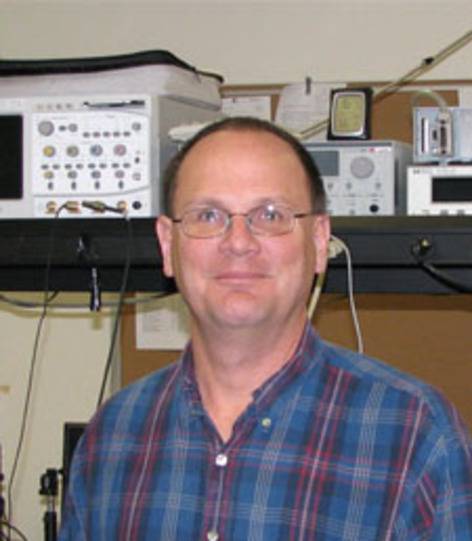Jon M. Pikal
EECS
Associate Professor

Education:
B.S. Electrical Engineering, Purdue University (1988)
M.S. Electrical Engineering, University of Colorado (1993)
Ph.D. Electrical Engineering, Colorado State University (1999)
Experience:
Associate Professor, University of Wyoming 2005 - present
Assistant Professor, University of Wyoming 1999 - 2005
Product Engineer, Intel Corp 1989 - 1991
Areas of Expertise:
Semiconductor Materials and Devices, Optoelectronic Devices, Solar Cells, Semiconductor Lasers
The primary goal of my lab is to investigate charge carrier dynamics in various semiconductor materials to help build better electronic and optoelectronic devices. We use optical excitation to look at charge carrier generation, recombination, and transport, as well as charge transfer across material interfaces. Frequently these materials are nanostructured materials such as quantum dots or nanowires or even combinations of these, where we study how charge moves among the different material layers. To conduct these studies, we have an ultrafast pulsed laser system consisting of a regenerative amplifier and optical parametric amplifier which allows us to excite the material with 100fs pulses at any wavelength we choose. With this system we conduct Transient Absorption (TA) spectroscopy with an optical delay line and white light probe and THz spectroscopy measurements. In addition, we have a Time Correlated Single Photon Counting setup which we use to conduct Time Resolved Photoluminescence (TRPL) measurements. In the past we have studied everything from quantum dots for semiconductor laser active regions to nanomaterials for new solar cell materials. We are currently conducting experiments on photocatalysts materials.
Selected Publications:
- Xu, Lifang, Dinesh Patel, Carmen S. Menoni, Jon M. Pikal, Jeng-Ya Yeh, J. Y. T. Huang, Luke J. Mawst, and Nelson Tansu. "Carrier Recombination Dynamics Investigations of Strain-Compensated InGaAsN Wells." 4.6 (2012): n. pag. Web.
- Singh, Umesh, Amit A. Dikshit, and Jon M. Pikal. "Rate Equation Modeling of Current Injection Efficiency in 1.3-micrometer InAs-InGaAs Quantum Dot Lasers." Proc. SPIE 8619, Phusics and Simulation of Optoelectronic Devices XXI, 861926 (March 14, 2013)
-
Alirza Orujov, Jon M. Pikal, TeYu Chien, Jeferson A. Carter, Saman A. Aryana, “Magnetic nanoparticle detection methods in the context of complex fluids,” International Journal of Coal Science & Technology 11, 86 (2024). https://doi.org/10.1007/s40789-024-00736-3
-
Thilini K. Ekanayaka, Dylan Richmond, Mason McCormick, Shashank R. Nandyala, Halle C. Helfrich, Alexander Sinitskii, Jon M. Pikal, Carolina C. Ilie, Peter A. Dowben and Andrew J. Yost, “Surface Versus Bulk State Transitions in Inkjet-Printed All-Inorganic Perovskite Quantum Dot Films,” Nanomaterials 2022, 12(22), 3956; https://doi.org/10.3390/nano12223956
-
Henry V. Wladkowski, Julian Duarte, Shashank R. Nandyala, Joshua S. Walker, Subash Kattel, Jeffrey L. Blackburn, Jeffrey A. Fagan, Jon M. Pikal, and William D. Rice, “Polyvinyl Acetate-Based Polymer Host for Optical and Far-Infrared Spectroscopy of Individualized Nanoparticles,” Journal of Applied Physics, 129, 034701 (2021); https://doi-org.libproxy.uwyo.edu/10.1063/5.0033611
-
Baichhabi R. Yakami, Uma Poudyal, Shashank R. Nandyala, Gaurab Rimal, Jason K. Cooper, Xuejie Zhang, Jing Wang, Wenyong Wang, and Jon M. Pikal, “Steady state and time resolved optical characterization studies of Zn2SnO4 nanowires for solar cell applications,” Journal of Applied Physics 120, 163101 (2016); doi: 10.1063/1.4965697
-
Sabit Horoz, Baichhabi Yakami, Uma Poudyal, Jon M. Pikal, Wenyong Wang, and Jinke Tang, “Controlled Synthesis of Eu2+ and Eu3+ doped ZnS Quantum Dots and Their Optical, Photovoltaic and Magnetic Properties,” AIP Advances, vol. 6, 045119, Apr 2016.
-
S. Horoz, Q. Dai, F.S. Maloney, B. Yakami, J.M. Pikal, X. Zhang, J. Wang, W. Wang and J. Tang, "Absorption Induced by Mn doping of ZnS for improved sensitized Quantum Dot Solar Cells," Phys. Rev. Applied 3, 024011, Feb. 2015.

